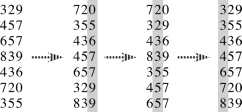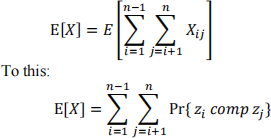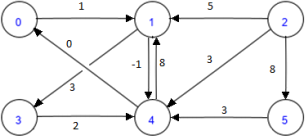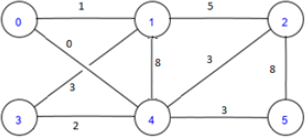CS483 – Fall 2023 Homework Week 14: Special Topics and Review
Hello, dear friend, you can consult us at any time if you have any questions, add WeChat: daixieit
CS483 – Fall 2023
Homework Week 14: Special Topics and Review
(Last Submission Date: SUNDAY, Dec. 3rd at 11:59pm)
Goal: Work through a set of paper-and-pencil style problems you might see on the subjects we’ve covered and topics you’ve seen in the past. This should prepare you for in-class tests and technical interviews, while reinforcing the topics.
Activity: Complete the following questions on paper and upload your answers to GradeScope.
Teamwork: None, this is a solo assignment.
Details
See overview of written homework assignments from Homework 2.
New-Item Questions
Graded, but not on correctness. You must show your work for points.
1. [1pts] Showing your scratch work (like we did in class), perform a counting sort where k = 0..6 on the following numbers: 1, 4, 2, 6, 0, 5, 1, 4
2. [1pts] Using the image shown below as a model, illustrate the operation of radix sort on the following English
words (using alphabetical order): TOT, SIT, SAT, SAY, SOY, ROY

3. [2pts] In the analysis of quick sort we did in class, we went from this:

Answer/explain in your own words (typed into GradeScope):
a) What does the E[] mean?
b) How do we get from the first equation to the second equation?
At a minimum, please address: Where did the E[] go on the right hand side? And where did the Pr{} come from? And what does zi and zj have to do with xij? etc.
Review-Item Questions
Graded based on correctness. You only need to show your work if asked.
We’ve done a lot of graph algorithms in CS483. Below is some review of several non-flow algorithms we’ve learned this semester. As an exercise, try to do these without looking at your notes first.
1. [1pts] Perform a depth first traversal of the graph shown below starting a Node 2 and breaking ties by choosing the lowest ID first. Write the order nodes are visited and finished below. Restart at the
lowest ID node not yet visited until all nodes are visited and finished.

Visiting order:
Finishing order:
2. [1pt] Perform a breadth first traversal of the graph from Review Problem 1 starting a Node 2 and breaking ties by choosing the lowest ID first. Write the order nodes are entered into the queue and their parent ID below that (e.g. if node 0 comes out of the queue first, you write 0 in the for queue order, and write its parent on the immediately below). Restart at the lowest ID node not yet visited until all nodes are visited.
Queue order:
Parent IDs:
3. [1.5pts] If we do Bellman-Ford’s Shortest Path Algorithm on the graph in Review Problem 1 starting a Node 2:
a. What does the first row of the table look like?
Answer:
b. What does the last row of the table look like?
Answer:
c. For the parallelizable algorithm, how many rounds/passes are needed to stop
(initialization does not count as a round/pass in this case)?
Answer:
4. [1pt] Perform Dijkstra’s Shortest Path algorithm on the following graph starting at Node 2 and giving the order nodes are finished and their parent IDs on the line below (match the parent ID to the node listed above).

Finishing order:
Parent IDs:
5. [1pt] Perform Kruskal’s Minimum Spanning Tree algorithm on the graph from Review Problem 4 and giving the list of edges used and in the order they would be chosen. E.g. if the edge 1--2 was selected first, then it is listed first.
6. [1pt] From which starting nodes is the same spanning tree discovered with Prim’s Minimum Spanning Tree algorithm? Circle all that apply:
0 1 2 3 4 5 None
Submission
Same as Homework 2, on GradeScope.
Grading Rubric
Same as Homework 2: Point breakdowns are given per-question. Total: 10 points. No extra credit. Answers from sources other than your own brain will result in an Honor Court referral.
2023-11-30